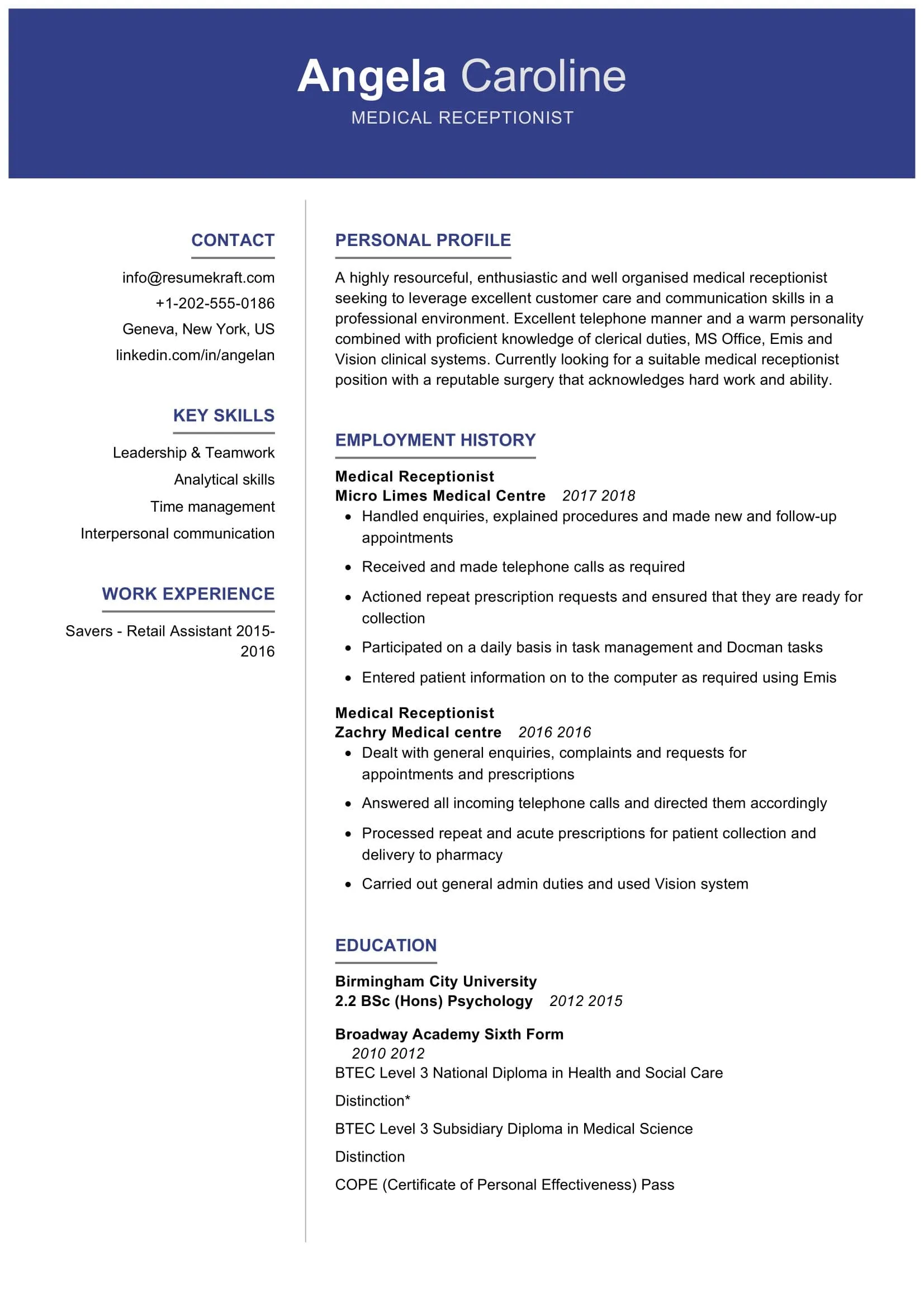Understanding the Medical Receptionist Role
The medical receptionist is a vital component of any healthcare environment, serving as the initial point of contact for patients and visitors. This role encompasses a wide range of responsibilities, from scheduling appointments and managing patient records to providing administrative support and ensuring the smooth operation of the front desk. A well-functioning medical reception area significantly contributes to the overall patient experience, establishing a positive first impression and fostering a sense of trust and professionalism. Understanding the intricacies of this role is crucial for crafting a compelling cover letter that highlights your suitability for the position. The best cover letters demonstrate not only an understanding of the role but also an eagerness to contribute to a positive and efficient healthcare setting, directly addressing the needs of patients and supporting the work of medical professionals. Moreover, demonstrating your understanding of HIPAA regulations and patient confidentiality is essential in this field, and your cover letter should reflect this awareness.
Key Responsibilities of a Medical Receptionist
Medical receptionists are tasked with a diverse set of responsibilities that are critical to the day-to-day operations of a medical facility. These duties often include managing patient appointments, which involves scheduling, rescheduling, and confirming appointments, as well as handling patient inquiries regarding availability and office policies. Patient registration is another key responsibility, entailing the collection of patient information, verifying insurance details, and updating medical records accurately. Receptionists also play a vital role in managing phone calls, directing calls to the appropriate staff members, and taking messages. Additionally, they handle billing and payment processing, addressing patient inquiries, and managing insurance claims. Maintaining organized medical records, ensuring patient confidentiality, and adhering to HIPAA regulations are paramount in fulfilling these responsibilities. These responsibilities highlight the need for strong organizational, communication, and problem-solving skills, as demonstrated in your cover letter through specific examples and relevant achievements.
Essential Skills for Medical Receptionists
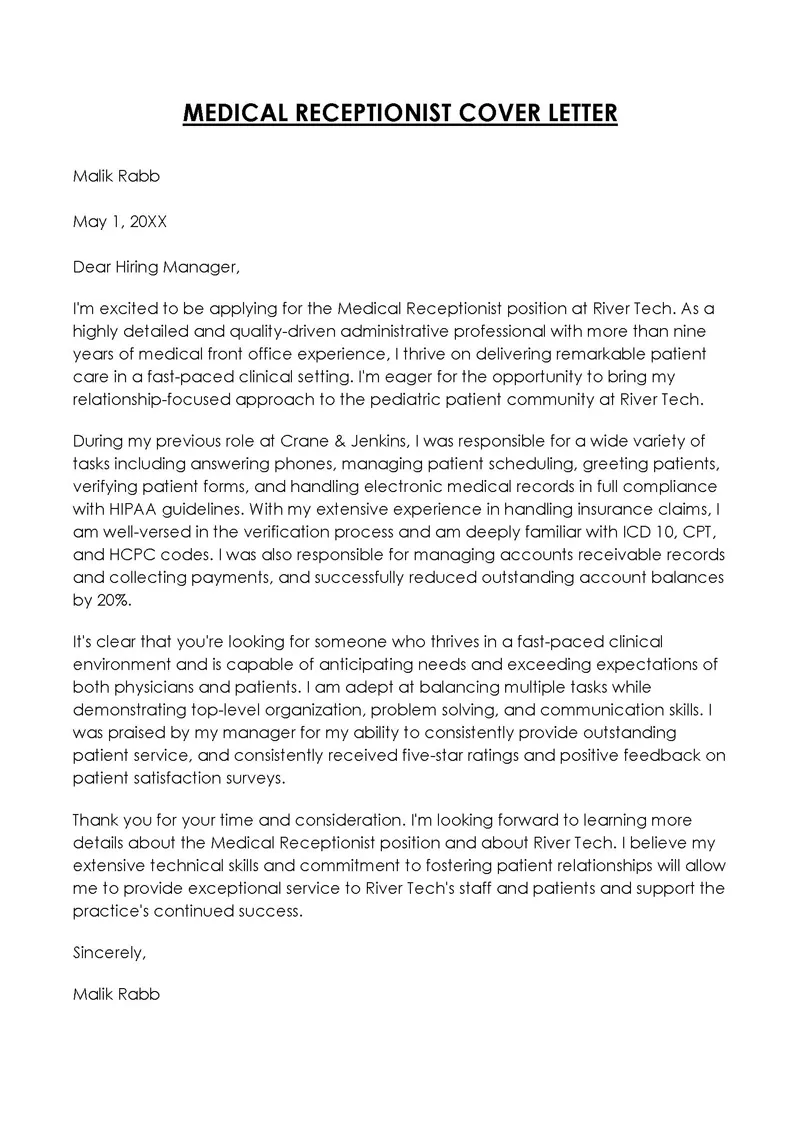
A successful medical receptionist possesses a blend of soft and hard skills that contribute to their effectiveness in the role. Excellent communication skills, both verbal and written, are essential for interacting with patients, physicians, and other staff members. Strong organizational skills are crucial for managing appointments, records, and other administrative tasks efficiently. Proficiency in computer skills, including electronic health records (EHR) systems and Microsoft Office Suite, is also highly valued. Moreover, receptionists need to demonstrate empathy, patience, and the ability to handle stressful situations with composure. The ability to multitask, prioritize tasks, and maintain accuracy in a fast-paced environment is also essential. Furthermore, a solid understanding of medical terminology and insurance procedures is beneficial. These skills, when highlighted in your cover letter with specific examples, will showcase your readiness to contribute to the smooth functioning of a medical office.
Crafting Your Medical Receptionist Cover Letter
Your medical receptionist cover letter serves as your introduction to a potential employer, offering you the opportunity to showcase your skills and qualifications. It’s an essential tool for making a strong first impression and distinguishing yourself from other applicants. The cover letter should be tailored to the specific job description, highlighting relevant experience and skills. It should also reflect your personality and demonstrate your enthusiasm for the position. A well-crafted cover letter not only supplements your resume but also provides context, elaborating on your qualifications and demonstrating how your skills align with the employer’s needs. By following a structured approach and focusing on key aspects of the role, you can create a cover letter that effectively communicates your suitability for the position and increases your chances of getting an interview. The ability to tailor your letter to each job, including specific examples of how your skills match the requirements, will significantly improve your success.
Header and Contact Information
The header of your medical receptionist cover letter should include your name, address, phone number, and email address. This information should be clearly displayed at the top of the letter. Following your contact information, include the date and the employer’s contact information, which should consist of the hiring manager’s name, title, the name of the clinic or medical office, and the address. Ensuring accuracy in this section is crucial, as it shows attention to detail and professionalism. If you are unsure of the hiring manager’s name, you can research the clinic’s website or call the office to find out. Addressing the cover letter to a specific person can significantly increase your chances of it being read and considered. This is the first step in demonstrating your ability to follow instructions and present yourself as a professional candidate.
The Salutation
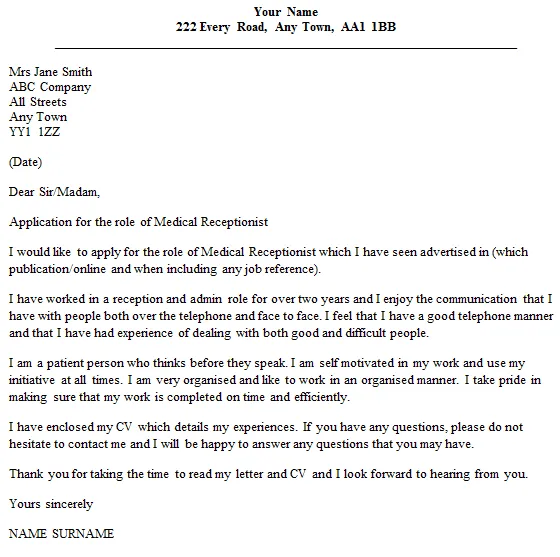
The salutation is the greeting used at the beginning of your cover letter. It’s essential to use a professional salutation, such as “Dear Mr./Ms./Mx. [Last Name],” if you know the hiring manager’s name. This personal touch adds a level of professionalism. If you are unable to find the name of the hiring manager, an acceptable alternative is “Dear Hiring Manager” or “Dear [Clinic Name] Team.” Avoid generic greetings like “To Whom It May Concern,” which can make your letter feel impersonal and less likely to capture the reader’s attention. The salutation sets the tone for the rest of your letter, so choosing the right one is a critical first step in presenting yourself effectively. It is important to be respectful and courteous, establishing a positive tone right from the beginning, which is crucial for the medical field.
Writing the Introduction
Your introduction is the hook that grabs the hiring manager’s attention. Briefly state the position you are applying for and where you found the job posting. Immediately express your enthusiasm for the role and the clinic, demonstrating your interest in their specific mission or values. Briefly mention a key skill or achievement that makes you a strong candidate. For instance, you could highlight your experience with patient scheduling software or your ability to handle high call volumes efficiently. Keep the introduction concise and focused, setting the stage for the rest of the letter. Avoid generic phrases and show immediately that you are a good fit. For example, state that you are excited to apply for the Medical Receptionist position at [Clinic Name], found on [Platform], and mention your experience handling patient inquiries and scheduling efficiently. This demonstrates your immediate value.
Highlighting Relevant Experience
The body of your cover letter should highlight your relevant experience, demonstrating how your skills and background align with the job requirements. Use specific examples to illustrate your abilities, such as managing patient records, handling insurance verification, or assisting with billing and payment processing. Focus on the skills and responsibilities mentioned in the job description. When describing your experience, provide quantifiable results whenever possible; this could involve the number of patients you assisted, the efficiency gains you achieved, or the positive feedback you received. Tailor your examples to the specific needs of the clinic, showing that you understand their requirements and are prepared to meet them. Mentioning specific software or systems you have experience with is also beneficial, as this indicates familiarity with the tools often used in medical offices. Using specific, relevant examples makes your cover letter much more compelling.
Quantifying Your Achievements
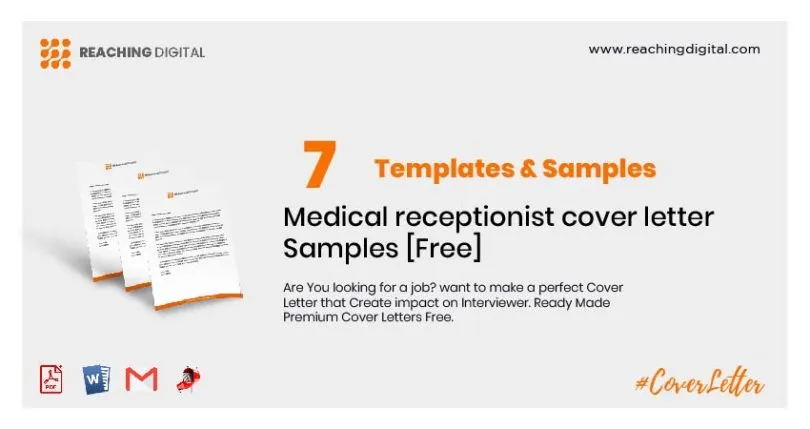
Quantifying your achievements is a powerful way to demonstrate the impact you have made in previous roles. Instead of simply stating you managed patient scheduling, provide metrics, such as “Successfully scheduled an average of 50 patients per day while maintaining a 98% accuracy rate.” If you improved patient satisfaction scores, provide those numbers to show the positive result of your efforts. Did you streamline any processes that led to efficiency gains? Quantify the time saved or the reduction in errors. Quantifiable results give hiring managers a clear understanding of your abilities and the value you can bring to their clinic. By using numbers, you make your accomplishments more credible and memorable, making you a more appealing candidate. For instance, you might state, “Reduced patient wait times by 15% through improved scheduling efficiency.” This quantifiable language speaks volumes about your effectiveness.
Showcasing Your Skills
In addition to highlighting your experience, you must showcase your skills. Focus on the skills most relevant to a medical receptionist position, such as communication, organization, and computer proficiency. Provide specific examples of how you have used these skills in the past. For example, when discussing your communication skills, describe how you handled difficult patient interactions or effectively explained complex medical information. To showcase your organizational skills, provide details about how you managed multiple tasks simultaneously or created efficient filing systems. Mentioning your proficiency in specific software, such as electronic health records (EHR) systems or Microsoft Office Suite, is crucial. Tailor your skills to match the job description, selecting the skills that are emphasized in the posting. Use action verbs to describe your skills and achievements, showing that you are a proactive and capable candidate. Highlighting these will show how you excel in key areas.
Emphasizing Your Personality and Fit
Beyond skills and experience, your cover letter should convey your personality and demonstrate that you would be a good fit for the clinic’s culture. Show your enthusiasm for the position and your commitment to providing excellent patient care. Briefly mention your interests or values that align with the clinic’s mission. For example, if the clinic emphasizes patient-centered care, you could mention your passion for helping others and ensuring a positive patient experience. Be genuine and let your personality shine through; however, keep the tone professional. Showcase your soft skills, such as empathy, patience, and problem-solving abilities, as these are crucial in the medical field. By demonstrating your personality and fit, you not only differentiate yourself from other candidates but also increase the likelihood of securing an interview. Demonstrate your awareness of the importance of maintaining a welcoming and supportive environment, which is key to establishing trust with patients.
Writing a Compelling Conclusion
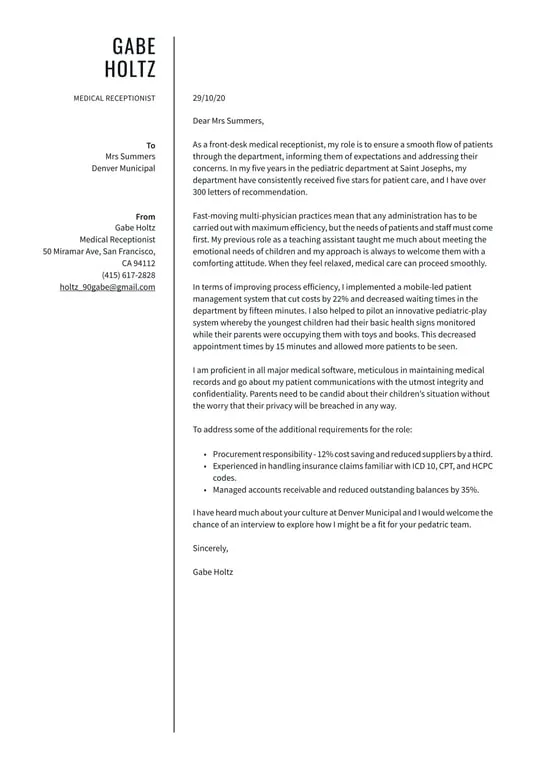
Your conclusion should summarize your key qualifications and reiterate your interest in the position. Thank the hiring manager for their time and consideration. Reiterate your enthusiasm for the opportunity and your belief that you would be a valuable asset to the team. Include a clear call to action, such as “I look forward to hearing from you soon” or “I am eager to discuss how my skills and experience can benefit your clinic.” Express your availability for an interview and provide your contact information again, just in case it is needed. Ensure that your conclusion leaves a positive and lasting impression. Ensure your eagerness and qualifications are very clear, making the hiring manager want to learn more about you. Demonstrate confidence in your ability to thrive in the role and contribute to the clinic’s success. Concluding with a strong, professional tone ensures a positive impression.
Proofreading and Editing Your Cover Letter
Before submitting your cover letter, carefully proofread and edit it. Ensure there are no grammatical errors, spelling mistakes, or typos. Errors can undermine your credibility and suggest a lack of attention to detail, which is particularly important in a medical environment. Read the letter aloud to check for awkward phrasing or sentences that do not flow well. Ask a friend or family member to review your letter for a fresh perspective. Pay close attention to formatting, making sure the letter is easy to read. Ensure your contact information is accurate and up-to-date. A well-proofread and edited cover letter demonstrates professionalism and attention to detail, making a positive impression on the hiring manager. Make sure every piece of information, from the name of the clinic to the details of your experience, is correct. Accuracy is critical.
Common Mistakes to Avoid
There are common mistakes that can hurt your chances of getting an interview. Avoid generic cover letters; always tailor your letter to each specific job. Avoid using overly casual language or slang. Do not include information that is irrelevant to the position, such as personal details or unrelated hobbies. Avoid exaggerating your skills or experience; honesty and accuracy are essential. Do not simply repeat the information from your resume; use the cover letter to provide context and elaborate on your qualifications. Avoid negative language or criticizing previous employers. Proofread carefully to eliminate any typos or grammatical errors. By avoiding these common mistakes, you can significantly increase the effectiveness of your cover letter and improve your chances of landing an interview. A poorly written letter can create a negative first impression, so focus on presenting yourself in the best possible light.
Using Action Verbs
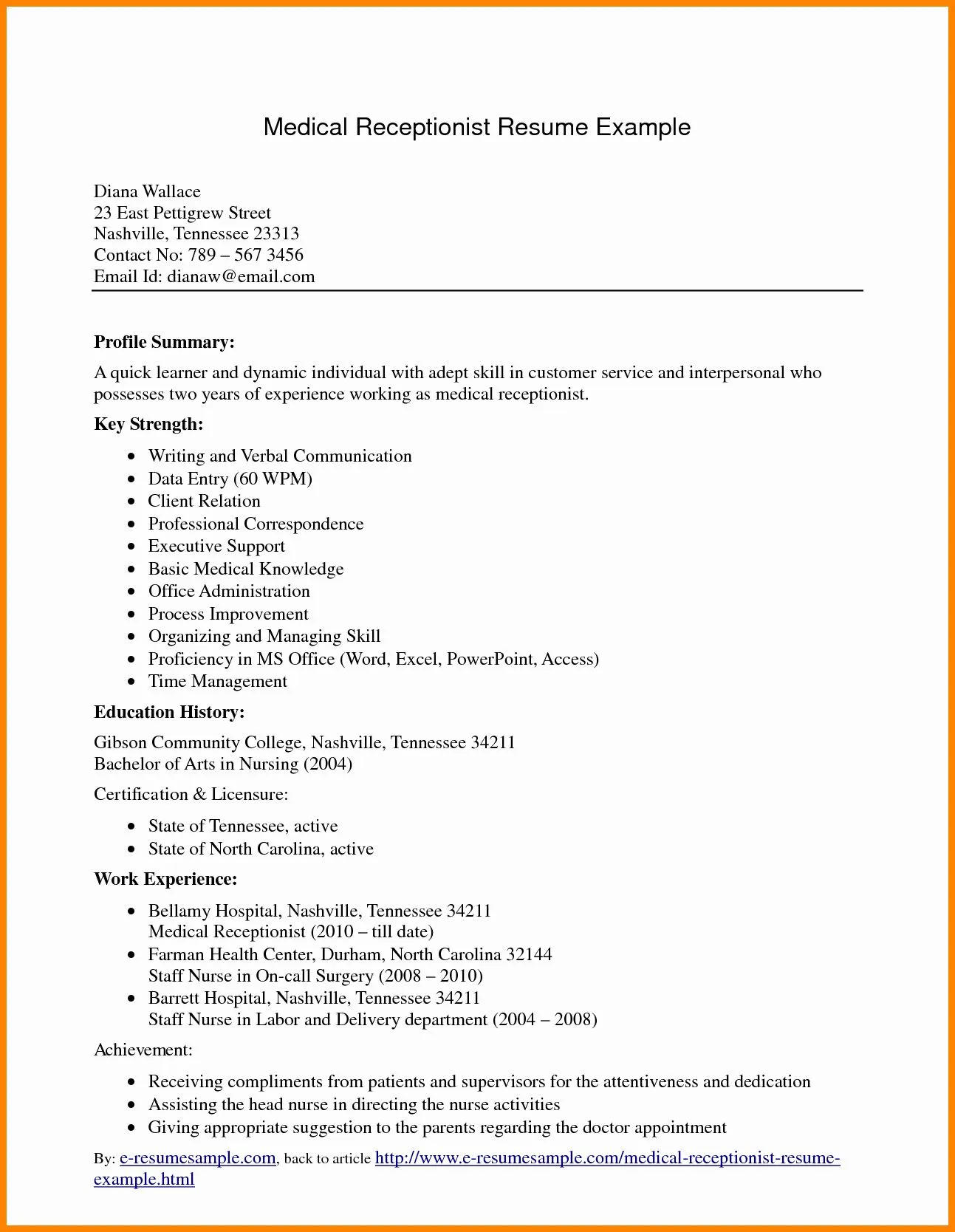
Using action verbs is a powerful way to make your cover letter more impactful and engaging. Action verbs bring your accomplishments to life and demonstrate your proactive approach. Start your sentences with strong verbs to describe your responsibilities and achievements. Some effective action verbs include “managed,” “coordinated,” “implemented,” “improved,” “streamlined,” “organized,” “trained,” and “assisted.” For example, instead of writing “Responsible for scheduling appointments,” write “Managed patient scheduling, resulting in a 10% reduction in appointment wait times.” Using action verbs makes your cover letter more dynamic and shows that you are a results-oriented individual. Choosing the right verbs will help you present yourself as a competent, capable, and motivated professional. This technique allows you to stand out.
Tailoring Your Cover Letter to the Job
One of the most important steps in writing an effective cover letter is tailoring it to the specific job. This means carefully reviewing the job description and identifying the key skills, qualifications, and requirements the employer is seeking. Highlight the experience and skills that are most relevant to the position. Use the same keywords and phrases from the job description in your cover letter. Research the clinic and its mission to show your genuine interest and understanding of its values. Personalize your letter by addressing the specific needs of the employer and explaining how your qualifications align with those needs. Tailoring your cover letter demonstrates that you have taken the time to understand the role and are genuinely interested in the opportunity. Generic letters are quickly discarded, so it’s crucial to show that you have the skills and experience to match the specific requirements of the job. This approach increases your chances of getting noticed and selected for an interview.
Formatting Your Cover Letter for Readability
The formatting of your cover letter is critical for readability. Use a professional font, such as Arial or Times New Roman, and ensure it is easy to read. Use a font size of 11 or 12 points. Maintain consistent spacing throughout the letter. Use clear headings and subheadings to break up the text and make it easier to scan. Use bullet points to highlight key skills and achievements, making the information more accessible. Keep paragraphs short and concise, avoiding long blocks of text. Ensure there is sufficient white space around your text, which prevents the letter from appearing cluttered. A well-formatted cover letter looks professional and makes it easier for the hiring manager to quickly grasp your qualifications. A professional format will enhance the overall presentation and demonstrate your attention to detail, reflecting positively on your abilities.
The Importance of a Professional Appearance
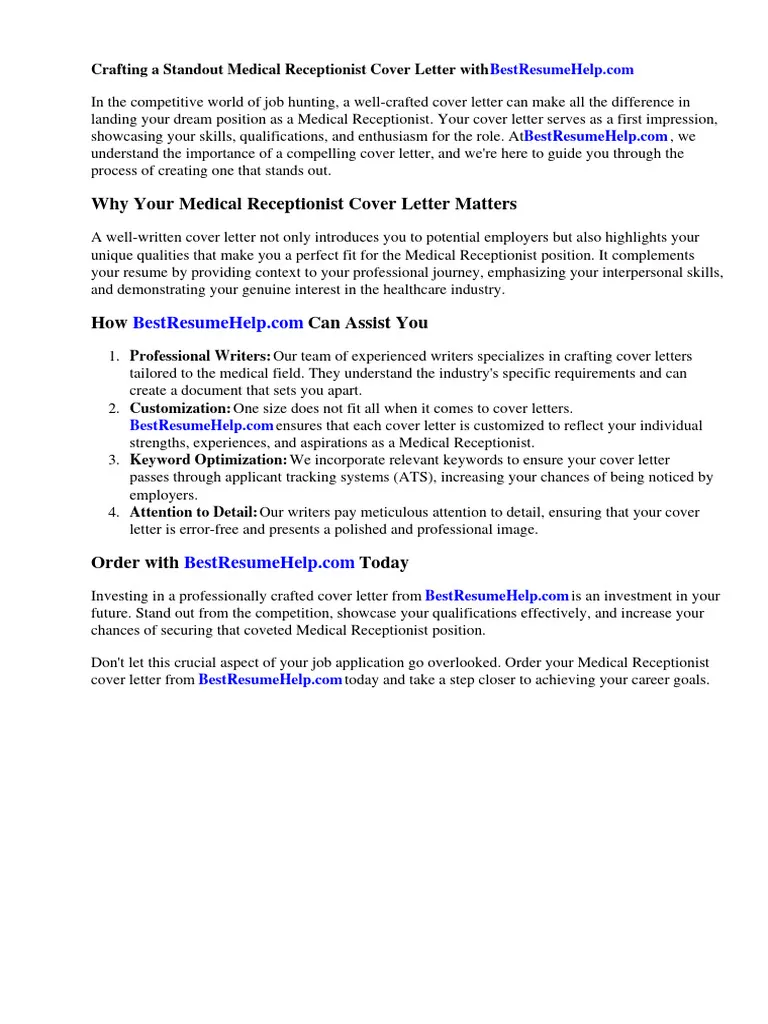
Your cover letter is a reflection of your professionalism and attention to detail. Ensure that your letter has a clean, professional appearance. Use high-quality paper and avoid any unnecessary formatting or embellishments. If submitting your cover letter electronically, save it as a PDF to preserve the formatting. Ensure the file name is professional, such as “YourName_CoverLetter.pdf.” Make sure your email address is professional; avoid using informal or unprofessional email addresses. A professional appearance shows the hiring manager that you take the application process seriously. It sets the stage for a positive first impression and suggests that you will maintain the same level of professionalism in your work. If your resume and cover letter look clean and professional, that tells a lot about you.
Following Up After Submission
After submitting your cover letter and resume, follow up with the employer. Send a thank-you email within a week or two of submitting your application. Thank the hiring manager for their time and reiterate your interest in the position. Briefly mention any specific skills or qualifications that make you a strong candidate. If you haven’t heard back within the timeframe specified in the job posting, you can also politely inquire about the status of your application. Keep your follow-up communication brief and professional. If you are not selected for an interview, express your appreciation for the opportunity and reiterate your interest in future opportunities. Following up demonstrates your initiative and enthusiasm for the position. It keeps you in the employer’s mind and shows your commitment to the hiring process.
